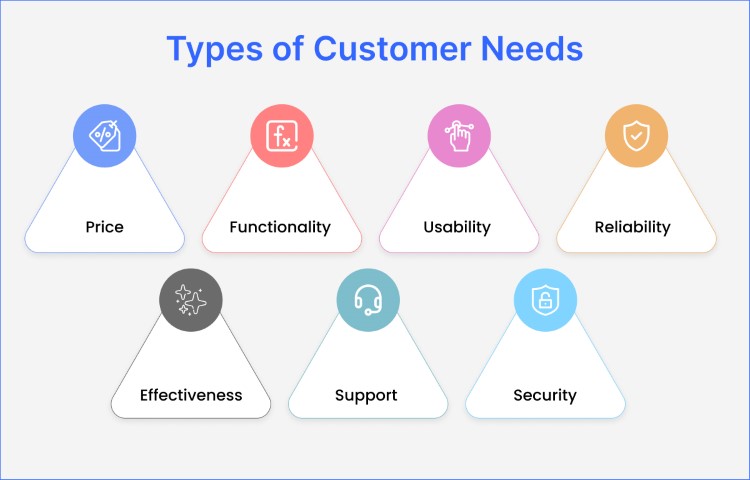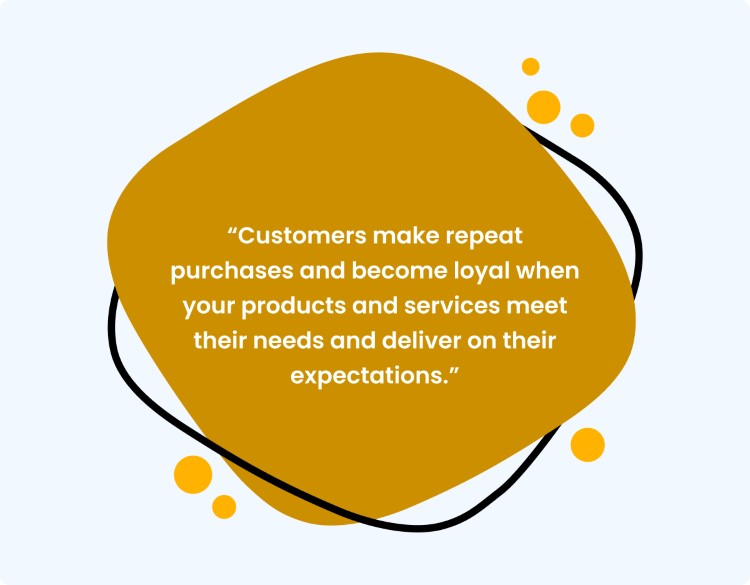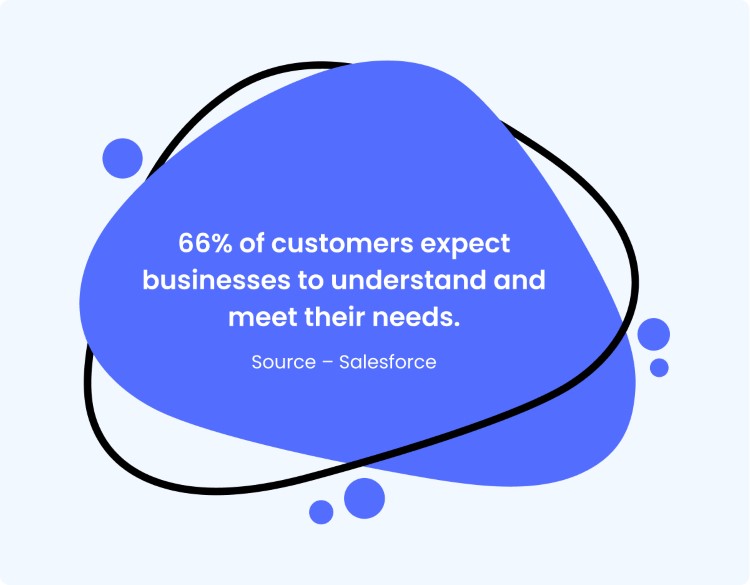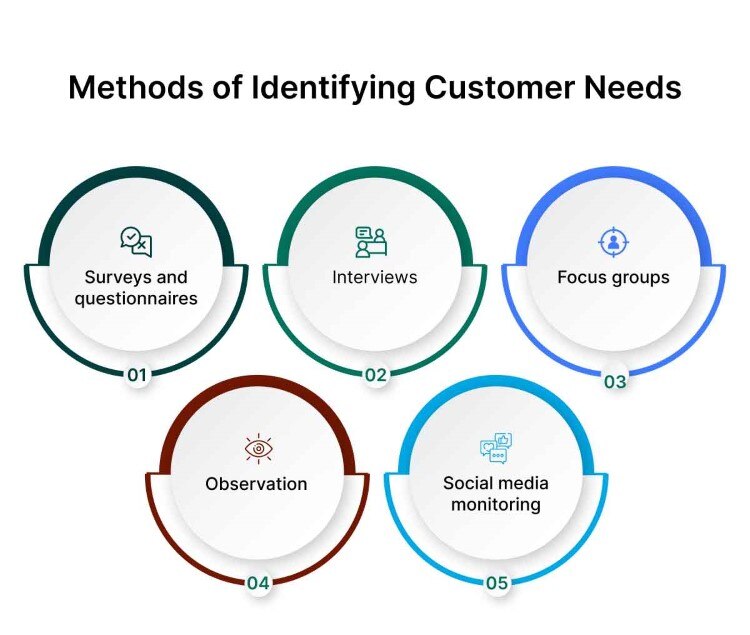Customer Needs Analysis – Definition, Types, Importance, Methods
- November 8, 2023
- 17 mins read
- Listen

A business becomes successful when it consistently delivers what its customer needs and wants. However, if a business does not care about meeting customer needs, it might fail to grow beyond a point.
Nokia is a good example to understand why customer needs analysis is important to stay competitive in the market and excel. The Finnish mobile maker was once the undisputed boss of the industry, enjoying dominance like never before. All this however could not last beyond a brief period starting in the late 90’s to early 2000s.
Its dominance started to lose grip over the market due to constantly changing consumer needs. Nokia could not foresee how users had started preferring smartphones more than the durable mobile phones it sold. Soon, competitors benefited from the gap in the market and took over, leaving Nokia to consign to a distant memory.
While there were other factors as well that contributed to the downfall of Nokia, its inability to adapt to the customer customer needs could well be the main point that started the slide.
This shows how a business must understand customer needs and deliver to those to stay relevant in the market. It’s equally important to know what customers want, why they want, and how to deliver what they need.
In this blog, we will explore customer need analysis in detail, understand what customer needs, why their needs are important, and how to assess those needs.
But before moving deeper, let’s first get started with understanding what exactly customer needs are….
What are Customer Needs?
As a business, you must understand why customers buy your products or services. Well, they may have some requirements, expectations, and desires to fulfill and that’s why they buy what they do. The purchases they make help solve a particular problem or purpose.

If customers did not have those desires and expectations, would your business exist, or any business exist? No. It’s the customer needs that drive businesses and that’s why you first have to identify those needs and then make products or services accordingly.
A business has to do customer needs analysis if it wants to meet and exceed expectations. Whether these needs are functional or aspirational, the focus should be on analyzing those needs and ensuring value specific to those needs.
Types of Customer Needs?
Customers have certain requirements and expectations that drive them to buy things. Their needs become the basis of purchase decisions. So, they buy a product or service to solve a specific problem. This shows how customer needs play a key role in what they want to buy and what not.
Here are some of the most common types of customer needs are –
- Price – Customers often expect a product or service to carry a specific price range. They have a budget in mind based on the unique value and quality of the product. In fact, customers are ready to pay even more if the overall experience exceeds their expectations with the product.
- Functionality – The product or service a customer buys should solve the specific problem it’s meant for. If it does, customers feel happy as the product or service will help effortlessly solve their problems. All this is only possible when the product has the intended functionalities and features expected by customers.

- Usability – Customers look to get a great experience with the use of the product. They want the product to be easy to use, smooth, and something that does not have complications. If a product helps them solve their problem easily, they will pay more to get it.
- Reliability – A good product is one that continues to perform well over time without any hiccups. Such products will be reliable and durable. If the product is not reliable, it might fail to meet the lofty expectations of customers.
- Effectiveness – A product or service must meet the promises it advertises. Customers feel happy when the product does its job effectively and helps solve the problem easily. If the product is not effective, it might cause lots of frustration for customers.
- Support – Poor customer service causes churn. If customer service is not good, a business might lose trust and goodwill as well. For customers, getting good customer service is one of the basic needs that must be met to keep them happy.
- Security – Risks to customers have grown in the digital world of transactions. Cases of theft of sensitive data and personal information are common now. Customers however expect a sense of security when they engage with a brand or buy a product or service.
Importance of Customer Needs
Understanding and addressing customer needs is central to business growth and success. If a business is able to meet customer needs on a consistent basis, it will achieve higher levels of customer loyalty and trust. Plus, 66% of customers expect businesses to understand and meet their needs.

There is a huge importance in understanding customer needs and the reasons are below –
- Meeting customer needs is the only way to ensure an increased level of customer satisfaction. Such customers tend to make repeat purchases and also recommend products or services to friends and family.
- A business that meets customer needs on a consistent basis finds it easy to stand out in the market and carves a niche based on the value it provides. Such a business will go on to achieve a competitive advantage.
- Retaining customers becomes easy for a business that takes steps to understand and meet customer needs. The more customers a business retains, the more it indicates its commitment to delivering on customer needs.
- Innovation and product development are possible only when a business listens to customer feedback and analyzes their needs and preferences. Such a customer-centric approach is often key to creating improved products and services.
- Unless a business is aware of what customer needs, how it can know their preferences and behaviors? A lack of customer needs analysis could affect its marketing and pricing decisions in the long run.

- A business can devise and implement tailored marketing campaigns only when it’s aware of what customer needs and wants. Based on the need analysis, it can craft personalized messages that resonate well with the audience.
- Customers make repeat purchases when the products and services meet their needs and deliver on their expectations. Such customers become loyal and their loyalty leads to a steady stream of increased revenue for the business.
- A business that takes steps to meet customer needs can often adapt to the ever-changing market conditions and trends. They not only stay relevant for a long and also build a positive reputation on the back of meeting customer needs on a regular basis.
Methods of Identifying Customer Needs
Every business is unique in terms of how to identify and meet customer needs. While some take the conventional route to assess the needs of their customers, others might adopt a more modern approach to know what their customers want. In every case, however, there are plenty of methods to choose, including –
1. Surveys and questionnaires
Surveys and questionnaires have always been effective methods for getting insights into customer preferences, requirements, and pain points. They can provide valuable quantitative data and specific information from a group of respondents.
Pro Tips
- Design a survey with a set of questions focusing on uncovering customer needs
- Define your target audience, segment them, and choose the most appropriate channel for survey distribution
- Promote the survey and analyze the data to identify common trends and patterns
2. Interviews
Interviews are a qualitative research method that a business can use to gain deep insights into customer needs and preferences. Compared to surveys and questionnaires, interviews give a more in-depth idea of customer needs as they involve one-on-one conversations between customers and the business.
Pro Tips
- Have a clearly defined purpose for the interviews and develop a structured guide to achieve your goals
- Choose the participants who give a wide range of perspectives and reach out to them through the right channels
- Use open-ended questions so that respondents feel encouraged to share their thoughts freely

3. Focus groups
Focus groups are a very helpful method to explore customer needs in a dynamic and interactive setting. They are qualitative research methods wherein a small group of audience engages in a guided discussion. The purpose of focus groups is to capture customer interactions and experiences that are otherwise not possible with surveys and interviews.
Pro Tips
- Devise a detailed plan with clarity on the composition of the group the topics and the format of the discussion
- Select participants that represent diversity and appoint a skilled moderator to guide the session
- Let one-ended topics or questions be discussed and then you transcribe and analyze the data
4. Observation
Observation is a good method to understand customer needs and wants. Many companies use this research technique to watch and document the behaviors and reactions of their target audience. You can observe customers either physically or on the web to gain a deep insight into their comfort level with your products or service.
Pro Tips
- Observe customers in their natural setting be it retail stores or during product usage
- Carefully watch them and then document their behavior
- Leverage ethnographic research to understand how customers use your products and find areas for improvement
5. Social media monitoring
Social channels have become very helpful platforms to understand customer behaviors and interactions. You just need to monitor social media platforms and online forums where you can track discussions related to your products, services, or industry.
Pro Tips
- Devise a social media strategy and choose the channels where your target group hangs out the most
- Engage with customers and gather feedback
- Reply to their comments and messages to gain insights into their needs
Steps to Perform a Customer Needs Analysis
A customer needs analysis is key to getting insight into your customer’s challenges and pain points. It helps a business in devising data-driven strategies to improve customer experiences and grow the business over time. After all, customer-centric companies are 65% more profitable than others.
Here is a step-by-step guide on performing a customer needs analysis –
Step 1 – Define your target audience
Defining your target audience is the first step when a business wants to do customer need analysis. In this step, the purpose is to understand the ideal customers and know their motivations, behaviors, and preferences. Knowledge of the target audience will prove helpful in focusing the effort on a specific group and ensuring value to them at each step of the way.
Pro Tips
- Create a detailed description of your ideal customer
- Consider key factors like age, gender, income level, and location
- Tailor your efforts to the specific needs of the audience

Step 2 – Conduct market research
Once you have defined your target audience, the next step in need analysis is to gather more information about them. The more information you have about your customers, the better you can meet their needs.
To conduct market research, you can employ one of the various methods or, combine one or more for effective results. You can send surveys, arrange focus groups, or conduct interviews. Plus, there are plenty of online analytic tools that can be used to gather customer data.
Pro Tips
- Use a mix of qualitative and quantitative methods
- Get a 36o-degree view of customer needs and preferences
- Collect data about the market as well
Step 3 – Review existing customer data
Adopting a data-driven approach is essential to understanding customer needs and wants. For data, your business can rely as much on new customers as on existing ones. In fact, a detailed analysis of the sales data and customer interactions related to existing customers can help identify customer needs in a better way.
Pro Tips
- Leverage historical data
- Analyze all the customer feedback and support interactions to get a good knowledge of customer problems
- Go through all customer complaints and see patterns if any as it will help in the improvement of the product or service
Step 4 – Map your customer journey
Meeting customer needs is easier said than done. If it were easy, every business would have a long list of happy customers. After all, it takes effort and a detailed understanding of the different customer touchpoints and how they interact with your business at each of those touchpoints.
This is why we need to map the customer journey as it will give visual clarity on the entire process where customers engage with your products or services. The key to this mapping is to analyze all the steps your customers take to engage with the business and all the touchpoints they go through, right from being a prospect to becoming a loyal customer.
Pro Tips
- Mapping customer journeys is essential to streamline fragmented efforts in meeting customer needs
- You can identify all the friction points of the customer journey and know the opportunities to improve
Step 5 – Analyze industry trends and do competitor analysis
Staying informed about the latest industry trends is one of the key aspects of meeting customer needs. When a business analyzes industry trends, it takes proactive steps to keep up with the changes in market conditions and customer preferences.
Similarly, to effectively meet customer needs, you should consider analyzing your competitors. This will help a lot in understanding their weaknesses and strengths. Based on the industry trends and competitor analysis, you can gain knowledge of various types of customer needs and take steps to meet them.
Pro Tips
- Leverage competitor analysis to gain insights into what you’re doing right and where you are falling short
- Know what customers in your industry value and deliver as per their specific needs
- Anticipate changing customer needs and focus on staying one step ahead of your competitors
Step 6 – Develop solutions
What after you have gained a clear understanding of your customer needs? Well, the next step is to develop solutions to address those needs. After all, the needs analysis you have done will serve the ultimate purpose when you use the findings to serve your customers well.
So, you should consider product improvements like adding new features to make your customers happy. You may think of entirely new offerings as well. Make sure you develop solutions based on the identified needs.
Pro Tips
- Brainstorm solutions in line with the needs identified
- Ensure the solutions are aligned with customer needs
Best Practices to Meet Customer Needs
Meeting customer needs effectively is key to the growth of any business. If you consistently meet and exceed customer expectations, you will achieve happy customers who, in turn, can lead to operational success. However, there are some best practices you need to follow to meet customer needs.
Here are the best practices to meet customer needs –
- Make a priority of understanding your target audience, their needs, and preferences by developing detailed personas.
- Focus on promptly addressing customer queries, inquiries, and doubts, and let them have clear information about your products or services.
- Regularly encourage customers to share feedback and promptly act on their suggestions as this can help improve your products or services.
- Offer personalized services that fit the specific needs of individual customers and maintain the consistency of your offers.
- Address customer issues quickly and offer round-the-clock and accessible support.
- Add new features based on customer feedback and innovate as per market trends as adapting to changing customer preferences is vital to meeting their needs.
- Regularly train your employees so that they have the skills to meet customer service expectations and feel empowered to make the right decisions.
- Take steps to encourage customer retention and reward loyalty or repeat purchases.
Best Tools for Analyzing Customer Needs
Analyzing customer needs is a key part of an effective business strategy. A business that regularly assesses the needs of its customers can meet those needs successfully. The good thing is there are several tools and software available for analyzing customer needs.
Here are the tools to analyze customer needs –
Customer Relationship Management (CRM) Software
CRM tools are very useful for analyzing customer needs. A business can use them to manage customer data, track interactions across channels or touchpoints, and better understand customer behavior and preferences. More so, the use of customer relationship software is extensive for targeted marketing and personalized communication. Some of the examples of CRM tools include Salesforce and Zoho CRM.
Surveys and Feedback Tools
Surveys and feedback are very important for understanding and analyzing customer needs. You can use survey tools to collect feedback from customers and understand many things, including their satisfaction levels, and their preferences. These tools are vital for businesses that want to implement client feedback into different areas for improvement. Some of the examples of survey and feedback tools include SurveyMonkey and Google Forms.
Analytics Software
The use of analytics tools is widespread in evaluating customer-centric data and information for understanding customer behavior and preferences. These tools are invaluable in implementing effective marketing strategies aligned with the various stages of the customer journey. Some of the examples of analytics software include Google Analytics and Mixpanel.
Heatmap and Session Recording Tools
Visualizing heatmaps and recording user sessions is essential for analyzing and understanding how users engage with your website. These tools are helpful for a comprehensive analysis of user interactions. You can use these tools to identify areas where engagement happens the most or least. Some of the examples of these tools include Hotjar and Crazy Egg.
Examples of Customer Needs Analysis
Needs analysis is a key aspect of business strategy for making informed decisions and improving products or services. Top businesses across industry verticals routinely engage in needs analysis to better understand their customers and achieve higher levels of customer satisfaction.
Here are some examples of customer needs analysis –
Apple Inc.:
Apple is a great example of how to leverage the power of needs analysis and achieve innovation in products. The company conducts regular surveys, collects user feedback, and does usability testing to assess the needs of customers. More so, it keeps a close eye on forums and social platforms, and support interactions for identifying areas of improvement.
Airbnb
Airbnb is another example of how to take customer needs analysis seriously and ensure value to them at each stage of their journey. It relies on reviews and ratings of each customer visit to address issues related to user experiences with its properties.
Zappos
The online shoe and clothing retailer Zappos always stands out for its customer-centric philosophy. It puts high priority on customer feedback and reviews as it encourages customers to share their experience with the brand’s offers. It uses customer feedback to enhance its product offerings.
Final Thoughts
Customer needs analysis is important for a business to improve user experience and add value to each stage of the journey.
Without a better understanding of customer needs, it would not be possible to meet the specific needs which might increase customer churn over time.
With REVE Chat, you can sign up and find a variety of engagement tools and see how they can contribute to your need analysis endeavor.



